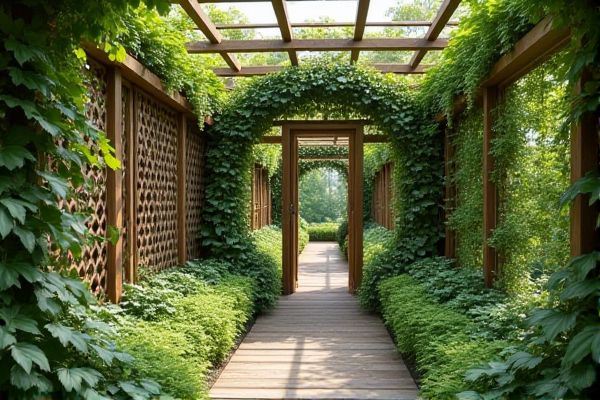
Lattice panels provide a sturdy, geometric structure ideal for supporting heavy vines, while trellises offer more open designs that promote airflow and sunlight exposure for healthy vine growth. Explore the rest of the article to discover which option best suits your garden's needs and enhances your vine cultivation.
Table of Comparison
| Feature | Lattice Panels | Trellis for Vines |
|---|---|---|
| Structure | Crisscross wooden or plastic panels forming square or diamond patterns | Framework of horizontal and vertical supports, often open and framed |
| Material | Wood, PVC, vinyl | Wood, metal, bamboo |
| Purpose | Provide decorative support and privacy screening | Support growing vines, improve air circulation and sun exposure |
| Space Efficiency | Compact, works well for fences and walls | Varies; can be larger structures for espalier or vertical growth |
| Installation | Easy to install as panels; attach directly to surfaces | Requires framing or stakes; more customizable |
| Durability | Moderate; depends on material and treatment | High; often sturdier for heavy vine growth |
| Maintenance | Periodic cleaning and painting or sealing | Regular pruning of vines and structural inspection |
| Best For | Privacy, garden aesthetics, light vine support | Heavy vine growth, training specific vine shapes, gardening |
Introduction: Lattice Panels vs Trellis
Lattice panels provide a sturdy, decorative framework ideal for supporting heavy vine growth and creating privacy, while trellises offer a more open, customizable structure suited for guiding vines along specific paths. Your choice depends on the desired aesthetic, space constraints, and the weight of the vines you plan to grow. Both options enhance outdoor spaces by promoting healthy vine development and improving garden design.
What Are Lattice Panels?
Lattice panels are structured grids made from wood, vinyl, or metal, designed to support climbing plants and vines. Their crisscross pattern creates ample spaces for vines to weave through, promoting healthy growth and airflow. Unlike trellises, lattice panels often serve as decorative screens or fencing while providing a strong foundation for plant expansion.
Defining Trellis Structures
Trellis structures provide essential support frameworks for climbing vines, commonly crafted from materials like wood or metal to facilitate plant growth and air circulation. Lattice panels, a specific type of trellis, consist of crisscrossed strips forming a grid pattern ideal for training vines and enhancing garden aesthetics. Choosing the right trellis system ensures your vines receive optimal exposure to sunlight and stability, promoting healthier growth and easier maintenance.
Aesthetic Appeal: Design Comparisons
Lattice panels offer a uniform grid pattern that provides a sleek and modern aesthetic, enhancing the visual appeal of your garden with clean lines and consistent spacing ideal for supporting climbing vines. Trellis designs, often more intricate and decorative, bring a charming, traditional look featuring varied shapes like arches or diamonds that complement rustic or cottage-style landscapes. Choosing between lattice panels and trellises depends on your desired aesthetic effect, with lattice creating a minimalist backdrop and trellises adding artistic flair to your vine display.
Material Durability and Maintenance
Lattice panels, often made from vinyl, wood, or metal, offer superior material durability with weather-resistant properties that require minimal maintenance, especially vinyl which resists rot and insect damage. Trellises, typically constructed from wood or metal, may need regular upkeep such as painting or sealing to prevent decay and rust, particularly in outdoor vine-growing environments. Choosing vinyl lattice panels can significantly reduce long-term maintenance efforts while providing sturdy support for vigorous vine growth.
Installation Ease and Flexibility
Lattice panels offer straightforward installation with pre-assembled grids that can be easily mounted on walls or frames, providing immediate support for vines to climb. Trellises, often customizable in shape and size, allow greater design flexibility and can be installed freestanding or attached, adapting to various garden layouts. Both options support vine growth effectively, but lattice panels suit quick, fixed installations while trellises excel in bespoke, adaptable setups.
Supporting Vine Growth: Which Performs Better?
Lattice panels provide a sturdy, evenly spaced framework that supports heavier vine growth and promotes better air circulation, reducing the risk of fungal diseases. Trellis structures, often simpler and lighter, offer ample vertical space but may lack the strength for more vigorous or mature vines. Your choice should depend on the vine species and desired growth pattern, with lattice panels typically performing better for long-term, robust vine support.
Cost Considerations and Budgeting
Lattice panels generally have higher initial costs due to their solid construction and durable materials, making them a long-term investment for supporting vines. Trellises are usually more budget-friendly, often made from lightweight wood or metal, but may require more frequent maintenance or replacement. When budgeting, consider both upfront expenses and ongoing durability to determine the most cost-effective option for vine support in your garden.
Outdoor Applications: Best Use Cases
Lattice panels offer robust support and privacy for larger outdoor spaces, making them ideal for creating shaded patios or dividing garden areas while allowing vines to climb evenly. Trellises are perfect for smaller or vertical spaces, providing targeted support for delicate vines and adding decorative flair to fences or walls. Your choice depends on the space size and aesthetic needs, with lattice panels suited for broad coverage and trellises for focused vine growth.
Conclusion: Choosing the Right Support for Your Vines
Lattice panels provide a sturdy and structured framework ideal for heavy or dense vine growth, supporting robust climbing and maximizing vertical space. Trellis systems offer flexibility with customizable designs that accommodate various vine types and garden aesthetics, facilitating easier pruning and air circulation. Selecting the right support depends on vine species, growth habits, space constraints, and desired garden design, ensuring optimal vine health and visual appeal.
 homyna.com
homyna.com